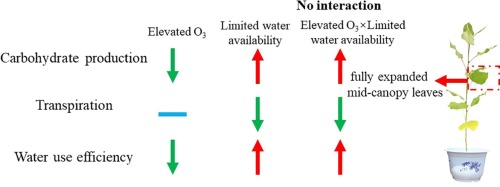当前位置:
X-MOL 学术
›
Forest Ecol. Manag.
›
论文详情
Our official English website, www.x-mol.net, welcomes your
feedback! (Note: you will need to create a separate account there.)
Limited water availability did not protect poplar saplings from water use efficiency reduction under elevated ozone
Forest Ecology and Management ( IF 3.7 ) Pub Date : 2020-04-01 , DOI: 10.1016/j.foreco.2020.117999 Yansen Xu , Zhaozhong Feng , Bo Shang , Xiangyang Yuan , Lasse Tarvainen
Forest Ecology and Management ( IF 3.7 ) Pub Date : 2020-04-01 , DOI: 10.1016/j.foreco.2020.117999 Yansen Xu , Zhaozhong Feng , Bo Shang , Xiangyang Yuan , Lasse Tarvainen

|
Abstract Elevated ground-level ozone (O3) concentrations decrease photosynthetic biochemistry more than stomatal conductance (gs), leading to an overall reduction in leaf-scale water use efficiency (WUE). Global warming is expected to lead to more severe and frequent droughts resulting in stomatal closure, increased WUE, and potentially in reduced plant O3 uptake and damage. It is currently unclear how the physiological responses to O3 and water limitation interact to affect overall leaf WUE and how these WUE responses might affect ecosystem productivity. In this study, we used open top chambers to expose O3-sensitive poplar saplings to elevated O3 (E-O3) and limited water availability to explore the individual and interactive effects of these stressors on WUE. We found that leaf-scale intrinsic water-use efficiency based on gas exchange measurements (iWUEge) decreased under E-O3 due to significantly reduced photosynthetic capacity, mesophyll conductance and apparent quantum yield, while gs was not affected by the treatment. Leaf-scale iWUEge and intrinsic WUE based on isotope measurements (iWUEiso) increased in the plants receiving less water due to higher photosynthetic capacities and lower transpiration rates indicated by δ18O measurements. The overall plant growth (total number of leaves, height, stem diameter and projected area of individual leaf) was significantly reduced under low water supply. Elevated O3 resulted in significant leaf senescence, but had no other significant main effect on morphological variables. Reduced water availability prevented O3-induced decreases in leaf mass per area and increases in leaf loss. No other significant O3-water availability interactions were detected in the measured physiological or morphological variables. Our results thus suggest that drought conditions will not prevent O3 damage to photosynthetic biochemistry in poplar and that high O3 concentrations will decrease leaf-scale iWUEge regardless of future changes in plant water availability.
中文翻译:

有限的可用水并不能保护杨树树苗在臭氧升高的情况下用水效率降低
摘要 升高的地面臭氧 (O3) 浓度比气孔导度 (gs) 更能降低光合生物化学,导致叶尺度水分利用效率 (WUE) 的整体降低。预计全球变暖将导致更严重和更频繁的干旱,导致气孔关闭、WUE 增加,并可能减少植物对 O3 的吸收和破坏。目前尚不清楚对 O3 的生理反应和水分限制如何相互作用以影响整体叶片 WUE,以及这些 WUE 反应如何影响生态系统生产力。在这项研究中,我们使用开顶室将 O3 敏感的杨树树苗暴露于升高的 O3 (E-O3) 和有限的可用水量,以探索这些压力源对 WUE 的个体和交互影响。我们发现,由于光合能力、叶肉电导和表观量子产率显着降低,基于气体交换测量 (iWUEge) 的叶尺度内在水分利用效率在 E-O3 下降低,而 gs 不受处理影响。由于较高的光合能力和较低的 δ18O 测量表明的蒸腾速率,叶片尺度 iWUEge 和基于同位素测量 (iWUEiso) 的内在 WUE 在接受较少水分的植物中增加。在低供水条件下,整个植物的生长(叶总数、高度、茎直径和单叶投影面积)显着降低。升高的 O3 导致显着的叶片衰老,但对形态变量没有其他显着的主影响。可用水量减少可防止 O3 引起的单位面积叶片质量下降和叶片损失增加。在测量的生理或形态变量中没有检测到其他显着的 O3-水可用性相互作用。因此,我们的结果表明,干旱条件不会阻止 O3 对杨树光合生物化学的损害,并且无论植物可用水量的未来变化如何,高 O3 浓度都会降低叶尺度 iWUEge。
更新日期:2020-04-01
中文翻译:

有限的可用水并不能保护杨树树苗在臭氧升高的情况下用水效率降低
摘要 升高的地面臭氧 (O3) 浓度比气孔导度 (gs) 更能降低光合生物化学,导致叶尺度水分利用效率 (WUE) 的整体降低。预计全球变暖将导致更严重和更频繁的干旱,导致气孔关闭、WUE 增加,并可能减少植物对 O3 的吸收和破坏。目前尚不清楚对 O3 的生理反应和水分限制如何相互作用以影响整体叶片 WUE,以及这些 WUE 反应如何影响生态系统生产力。在这项研究中,我们使用开顶室将 O3 敏感的杨树树苗暴露于升高的 O3 (E-O3) 和有限的可用水量,以探索这些压力源对 WUE 的个体和交互影响。我们发现,由于光合能力、叶肉电导和表观量子产率显着降低,基于气体交换测量 (iWUEge) 的叶尺度内在水分利用效率在 E-O3 下降低,而 gs 不受处理影响。由于较高的光合能力和较低的 δ18O 测量表明的蒸腾速率,叶片尺度 iWUEge 和基于同位素测量 (iWUEiso) 的内在 WUE 在接受较少水分的植物中增加。在低供水条件下,整个植物的生长(叶总数、高度、茎直径和单叶投影面积)显着降低。升高的 O3 导致显着的叶片衰老,但对形态变量没有其他显着的主影响。可用水量减少可防止 O3 引起的单位面积叶片质量下降和叶片损失增加。在测量的生理或形态变量中没有检测到其他显着的 O3-水可用性相互作用。因此,我们的结果表明,干旱条件不会阻止 O3 对杨树光合生物化学的损害,并且无论植物可用水量的未来变化如何,高 O3 浓度都会降低叶尺度 iWUEge。











































 京公网安备 11010802027423号
京公网安备 11010802027423号